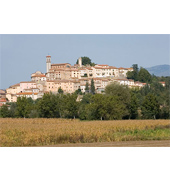MONTERCHI
When you leave Arezzo, head towards the Foce di Scopetone and , on reaching Palazzo del Pero, stop at the Pieve di San Donnino a Maiano. Built towards the 10th century, the church underwent various reconstructions and transformations starting from the 14th century, but some 15th-century frescoes remain in the apse. Drive on now to Monterchi, an ancient castle founded around the 11th century. Because of its strategic position on the Tuscan-Umbrian frontier, a perimeter of walls was erected around the castle in the the Middle Ages. It was under the domination of the Tarlati di Pietramala family until 1440, when it subsequently passed into the hands of the Florentines and the walls were reinforced. Some sections of these remain but, due to reconstructions and earthquakes, a number of ancient buildings have been lost, including the Romanesque Pieve. Dedicated to St Simeon and documented as far back as 1230, the church was, like the castle, under the patronage of the Tarlati di Pietramala family. Subsequently enlarged and transformed, it was reconstructed between1830 and 1832, and finally rebuilt around 1960.
The church possesses some artworks of a certain value and you can see a late 15th-century Ciborium, possibly attributable to Andrea Sansovino, and a Presentation in the Temple by Durante Alberti. Outside the walls and on the road going towards Città di Castello, you find the Cappella di Santa Maria de Momentana (or de Silva) which was first mentioned in the 13th century. In 1785, with its dimensions reduced, it was transformed into a cemetery chapel after which, in 1956, it was completely rebuilt. At the high altar, the fresco of the Madonna del Parto by Piero della Francesca was once housed. (It is sometimes known as the “pregnant Madonna”.) It was detached in 1911 and today has found a specially provided home in the Museo “Madonna del Parto”. Here, you can also follow a very informative display documenting the various phases of the fresco’s restoration. Piero della Francesca, who was born in nearby San Sepolcro, probably painted this extraordinary work around 1455, at approximately the same time he was painting the Cycle of the True Cross in the Chiesa di San Francesco, Arezzo. Even though visitors come to Monterchi primarily to see Piero’s Madonna, the Chiesa di Sant’Apollinare alle Ville is also worth visiting. Going back to the 12th century, this church retains its ancient semi-circular apse and, despite changes made to the interior over the years, you can still see 15th and 16th-century frescoes.
On the road from Monterchi to Anghiari, you pass the Pieve di Santa Maria a Corsano which, as far back as 1198, was a possession of the Camaldolese monks. The building is made interesting, and is indeed rather unusual, because of the bell tower from the 12th-13th centuries which rises over the entrance portal, and which appears to be a typical solution of French Romanesque architecture. The single nave of the interior was modified during the the 15th century, while the high altar from the 17th century has as fresco of the Madonna del Latte, an Arezzo work attributable to the 14th century.
|
|

|
|

